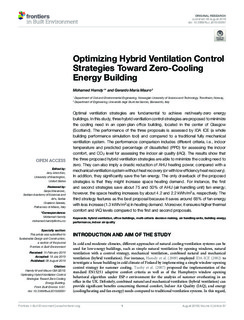| dc.contributor.author | Hassan Mohamed, Mohamed Hamdy | |
| dc.contributor.author | Mauro, Gerardo Maria | |
| dc.date.accessioned | 2020-02-07T07:19:17Z | |
| dc.date.available | 2020-02-07T07:19:17Z | |
| dc.date.created | 2019-07-18T23:28:12Z | |
| dc.date.issued | 2019 | |
| dc.identifier.citation | Frontiers in Built Environment. 2019, 5 (97), . | nb_NO |
| dc.identifier.issn | 2297-3362 | |
| dc.identifier.uri | http://hdl.handle.net/11250/2640133 | |
| dc.description.abstract | Optimal ventilation strategies are fundamental to achieve net/nearly-zero energy buildings. In this study, three hybrid ventilation control strategies are proposed to minimize the cooling need in an open-plan office building, located in the center of Glasgow (Scotland). The performance of the three proposals is assessed by IDA ICE (a whole building performance simulation tool) and compared to a traditional fully mechanical ventilation system. The performance comparison includes different criteria (i.e., indoor temperature and predicated percentage of dissatisfied (PPD) for assessing the indoor comfort and CO2 level for assessing the indoor air quality). The results show that the three proposed hybrid ventilation strategies are able to minimize the cooling need to zero. They can also imply a drastic reduction of AHU heating power, compared with a mechanical ventilation system without heat recovery (or with low efficiency heat recovery). In addition, they significantly save the fan energy. The only drawback of the proposed strategies is that they might increase the space heating demand. For instance, the first and second strategies save about 75% and 50% of AHU (air handling unit) fan energy; however, the space heating increases by about 4.2 and 2.2 kWh/m2a, respectively. The third strategy features as the best proposal because it saves around 68% of fan energy with less increase (1.3 kWh/m2a) in space heating demand. Moreover, it ensures higher thermal comfort and indoor air quality levels compared to the first and second proposals. | nb_NO |
| dc.language.iso | eng | nb_NO |
| dc.publisher | Frontiers Media | nb_NO |
| dc.rights | Navngivelse 4.0 Internasjonal | * |
| dc.rights.uri | http://creativecommons.org/licenses/by/4.0/deed.no | * |
| dc.title | Optimizing Hybrid Ventilation Control Strategies Toward Zero-Cooling Energy Building | nb_NO |
| dc.type | Journal article | nb_NO |
| dc.type | Peer reviewed | nb_NO |
| dc.description.version | publishedVersion | nb_NO |
| dc.source.pagenumber | 15 | nb_NO |
| dc.source.volume | 5 | nb_NO |
| dc.source.journal | Frontiers in Built Environment | nb_NO |
| dc.source.issue | 97 | nb_NO |
| dc.identifier.doi | 10.3389/fbuil.2019.00097 | |
| dc.identifier.cristin | 1712024 | |
| dc.description.localcode | Copyright © 2019 Hamdy and Mauro. This is an open-access article distributed under the terms of the Creative Commons Attribution License (CC BY). The use, distribution or reproduction in other forums is permitted, provided the original author(s) and the copyright owner(s) are credited and that the original publication in this journal is cited, in accordance with accepted academic practice. No use, distribution or reproduction is permitted which does not comply with these terms. | nb_NO |
| cristin.unitcode | 194,64,91,0 | |
| cristin.unitname | Institutt for bygg- og miljøteknikk | |
| cristin.ispublished | true | |
| cristin.fulltext | original | |
| cristin.qualitycode | 1 | |

